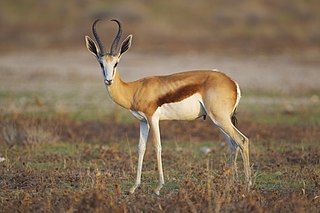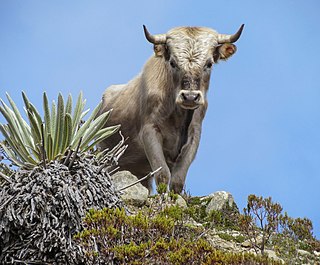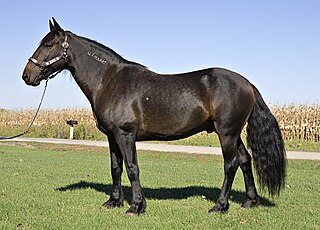
At 824,292 km2 (318,261 sq mi), Namibia is the world's thirty-fourth largest country. After Mongolia, Namibia is the second least densely populated country in the world. Namibia got its name from the Namib desert that stretches along the coast of the Atlantic. It is also known for its wildlife.

The springbok or springbuck is a medium-sized antelope found mainly in south and southwest Africa. The sole member of the genus Antidorcas, this bovid was first described by the German zoologist Eberhard August Wilhelm von Zimmermann in 1780. Three subspecies are identified. A slender, long-legged antelope, the springbok reaches 71 to 86 cm at the shoulder and weighs between 27 and 42 kg. Both sexes have a pair of black, 35-to-50 cm (14-to-20 in) long horns that curve backwards. The springbok is characterised by a white face, a dark stripe running from the eyes to the mouth, a light-brown coat marked by a reddish-brown stripe that runs from the upper fore leg to the buttocks across the flanks like the Thomson's gazelle, and a white rump flap.

Przewalski's horse, also called the takhi, Mongolian wild horse or Dzungarian horse, is a rare and endangered horse originally native to the steppes of Central Asia. It is named after the Russian geographer and explorer Nikolay Przhevalsky. Once extinct in the wild, it has been reintroduced to its native habitat since the 1990s in Mongolia at the Khustain Nuruu National Park, Takhin Tal Nature Reserve, and Khomiin Tal, as well as several other locales in Central Asia and Eastern Europe.

The Namib is a coastal desert in Southern Africa. According to the broadest definition, the Namib stretches for more than 2,000 kilometres (1,200 mi) along the Atlantic coasts of Angola, Namibia, and northwest South Africa, extending southward from the Carunjamba River in Angola, through Namibia and to the Olifants River in Western Cape, South Africa. The Namib's northernmost portion, which extends 450 kilometres (280 mi) from the Angola-Namibia border, is known as Moçâmedes Desert, while its southern portion approaches the neighboring Kalahari Desert. From the Atlantic coast eastward, the Namib gradually ascends in elevation, reaching up to 200 kilometres (120 mi) inland to the foot of the Great Escarpment. Annual precipitation ranges from 2 millimetres (0.079 in) in the aridest regions to 200 millimetres (7.9 in) at the escarpment, making the Namib the only true desert in southern Africa. Having endured arid or semi-arid conditions for roughly 55–80 million years, the Namib may be the oldest desert in the world and contains some of the world's driest regions, with only western South America's Atacama Desert to challenge it for age and aridity benchmarks.

A feral animal or plant is one that lives in the wild but is descended from domesticated individuals. As with an introduced species, the introduction of feral animals or plants to non-native regions may disrupt ecosystems and has, in some cases, contributed to extinction of indigenous species. The removal of feral species is a major focus of island restoration.

The Namib-Naukluft Park is a national park in western Namibia, situated between the coast of the Atlantic Ocean and the edge of the Great Escarpment. It encompasses part of the Namib Desert, the Naukluft mountain range, and the lagoon at Sandwich Harbour. The best-known area of the park and one of the main visitor attractions in Namibia is Sossusvlei, a clay pan surrounded by dunes, and Sesriem, a small canyon of the Tsauchab. The desert research station of Gobabeb is situated within the park.

The Konik or Polish Konik is a Polish breed of pony. There are semi-feral populations in some regions. They are usually mouse dun or striped dun in color.

The term tarpan refers to free-ranging horses of the Eurasian steppe from the 18th to the 20th century. It is generally unknown whether those horses represented genuine wild horses, feral domestic horses or hybrids. The last individual believed to be a tarpan died in captivity in the Russian Empire in 1909.

The mustang is a free-roaming horse of the Western United States, descended from horses brought to the Americas by the Spanish. Mustangs are often referred to as wild horses, but because they are descended from once-domesticated animals, they are actually feral horses. The original mustangs were Colonial Spanish horses, but many other breeds and types of horses contributed to the modern mustang, now resulting in varying phenotypes. Some free-roaming horses are relatively unchanged from the original Spanish stock, most strongly represented in the most isolated populations.

The Damara, plural Damaran are an ethnic group who make up 8.5% of Namibia's population. They speak the Khoekhoe language and the majority live in the northwestern regions of Namibia, however they are also found widely across the rest of the country.

The Exmoor Pony is a British breed of pony or small horse. It is one of the mountain and moorland pony breeds native to the British Isles, and so falls within the larger Celtic group of European ponies. It originates on, and is named for, the Exmoor area of moorland in north-eastern Devon and western Somerset, in south-west England, and is well adapted to the climate conditions and poor grazing of the moor. Some still live there in a near-feral state, but most are in private ownership.

The gemsbok, or South African oryx, is a large antelope in the genus Oryx. It is endemic to the dry and barren regions of Botswana, Namibia, South Africa and Zimbabwe, mainly inhabiting the Kalahari and Namib Deserts, areas in which it is supremely adapted for survival. Previously, some sources classified the related East African oryx, or beisa oryx, as a subspecies.

A feral horse is a free-roaming horse of domesticated stock. As such, a feral horse is not a wild animal in the sense of an animal without domesticated ancestors. However, some populations of feral horses are managed as wildlife, and these horses often are popularly called "wild" horses. Feral horses are descended from domestic horses that strayed, escaped, or were deliberately released into the wild and remained to survive and reproduce there. Away from humans, over time, these animals' patterns of behavior revert to behavior more closely resembling that of wild horses. Some horses that live in a feral state but may be occasionally handled or managed by humans, particularly if privately owned, are referred to as "semi-feral".

Namibia is one of few countries in the world to specifically address habitat conservation and protection of natural resources in their constitution. Article 95 states, "The State shall actively promote and maintain the welfare of the people by adopting international policies aimed at the following: maintenance of ecosystems, essential ecological processes, and biological diversity of Namibia, and utilization of living natural resources on a sustainable basis for the benefit of all Namibians, both present and future.".

The Misaki is a critically-endangered Japanese breed of small horse. It is one of eight Japanese native horse breeds, and lives as a feral horse in a natural setting in a designated National Monument on Cape Toi within the municipal boundaries of Kushima at the south end of Miyazaki Prefecture on the island of Kyūshū. The Misaki was made a Japanese National Natural Treasure in 1953.

Aus is a settlement in the ǁKaras Region of southern Namibia. It lies on a railway line and the B4 national road, 230 km west of Keetmanshoop and about 125 km east of Lüderitz and belongs to the ǃNamiǂNûs electoral constituency. Trains from Keetmanshoop now end their journey at the village but formerly continued on to Lüderitz. The settlement is small but has a number of amenities including a hotel, police station, shop and garage. It is located in the Aus Mountains above the plains of the Namib Desert. The climate is usually hot and arid but snow has been recorded in the winter of 1963, and the area features the coldest winters recorded in Namibia.
The Pryor Mountains Wild Horse Range is a refuge for a historically significant herd of free-roaming mustangs, the Pryor Mountain mustang, feral horses colloquially called "wild horses", located in the Pryor Mountains of Montana and Wyoming in the United States. The range has an area of 39,650 acres (160.5 km2) and was established in 1968 along the Montana–Wyoming border as the first protected refuge dedicated exclusively for mustangs. It was the second feral horse refuge in the United States. About a quarter of the refuge lies within the Bighorn Canyon National Recreation Area. A group of federal agencies, led by the Bureau of Land Management, administers the range.

The Pryor Mountain mustang is a substrain of mustang considered to be genetically unique and one of the few strains of horses verified by DNA analysis to be descended from the original Colonial Spanish horses brought to the Americas by the Spanish. They live on the Pryor Mountains Wild Horse Range located in the Pryor Mountains of Montana and Wyoming in the United States, and are the only mustang herd remaining in Montana, and one of sixteen in Wyoming. They are protected by the Wild and Free-Roaming Horses and Burros Act of 1971 (WFRHBA) and managed by the Bureau of Land Management (BLM), who has set the optimum herd number at 120 animals. Genetic studies have revealed that the herd exhibits a high degree of genetic diversity and a low degree of inbreeding, and BLM has acknowledged the genetic uniqueness of the herd. Pryor Mountain Mustangs are relatively small horses, exhibit a natural ambling gait, and domesticated Pryor Mountain mustangs are known for their strength, sure-footedness and stamina. The Pryor Mountains Wild Horse Range is one of the most accessible areas to view feral horse herds in the United States and tourism to the area has increased in recent years.

The Cumberland Island horses are a band of feral horses living on Cumberland Island in the state of Georgia. Popular myth holds that horses arrived on the island sometime in the 16th century with the arrival of the Spanish conquistadors. However, it is unlikely that any horses left by the Spanish survived, and more likely the current population descends from horses brought to the island in the 18th century by the English. Cumberland Island became part of the Cumberland Island National Seashore in 1972 when the National Park Service (NPS) took over its management. These horses are similar to the bands of horses living on the islands of Chincoteague and Assateague. There is estimated to be a population of between 150 and 200 horses on the island. Horses on Cumberland Island have a relatively short life expectancy, due to pest infestations, disease and their rugged environment. In 2000 a behavioral study found that instability marks the bands, with large numbers of co-dominant stallions, early dispersal of juveniles, and frequent band-changing among mares.

The Kundudo horse is a population of wild horse native to Mount Kundudo in eastern Ethiopia. There are very few of them, but have been known to the local population for two centuries. They may have come from a small group of Abyssinian horses lost during military conflicts in the 16th century.

























